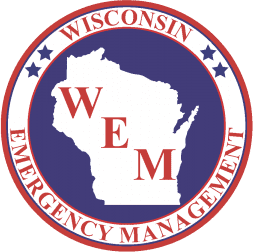For Immediate Release
Contact: dmawempio@widma.gov
MADISON, Wis. – In response to the severe flooding affecting southeast Wisconsin, the State Emergency Operations Center (SEOC) has been activated since Sunday, August 10, 2025. This coordinated activation enables personnel from Wisconsin Emergency Management (WEM), the Department of Natural Resources, the Wisconsin National Guard and other state and local agencies to collaborate efficiently in providing critical assistance to impacted communities across the region.
Governor Tony Evers issued an official state of emergency declaration on August 10 to authorize a swift and coordinated response. This declaration allows the state to utilize emergency funds immediately and streamlines the process to request federal assistance. By declaring a state of emergency, Wisconsin is eligible to seek federal disaster relief and recovery resources through the Federal Emergency Management Agency (FEMA).
The National Weather Service reported that multiple counties in southeast Wisconsin experienced historic rainfall over the weekend, with some areas of Milwaukee and Waukesha counties receiving over 10 inches of rain. This unprecedented precipitation caused widespread flooding, leading to significant property damage, power outages, numerous road closures, emergency evacuations, and multiple swift-water rescues.
During the SEOC activation, WEM staff have been coordinating closely with county emergency managers to process requests for vital resources, including high-water vehicles, sandbagging equipment, bottled water, and volunteer coordination support. State and local agencies, private businesses, municipalities and nonprofit organizations have come together to pool resources and provide aid where it is most needed.
With immediate threats from high water subsiding, the focus has shifted to recovery efforts. Damage assessments began on Tuesday, August 12, and continue to be conducted by WEM staff, the Incident Management Team, and the Department of Natural Resources. These assessments are critical for determining the full extent of the damage and whether the thresholds for a Presidential Disaster Declaration have been met.
Once damage assessments are compiled, the Governor’s office will submit a formal request to the president, through FEMA and the U.S. Department of Homeland Security, seeking a federal disaster declaration. If approved, this declaration unlocks additional federal funding and resources to support long-term recovery, including grants to individuals and families, public infrastructure repair funds, and support for local governments.
Residents traveling in the affected areas are strongly urged to visit 511wi.gov for up-to-date road closure and safety information. Drivers should never attempt to travel through standing or moving floodwaters; if you encounter flooded roads, turn around and seek an alternate route.
WEM encourages all residents impacted by the flooding to call 211 to report property damage such as flooded basements, structural damage, or other flood-related impacts. The 211 hotline also provides access to local resources, including emergency shelters, food assistance, and cleanup support.
Wisconsin remains committed to supporting its communities through this challenging time. The State Emergency Operations Center remains active and vigilant to ensure the health, safety, and recovery of all affected Wisconsinites.
NOTE: Please see the attached document for answers to frequently asked questions regarding the recovery process and resources.

